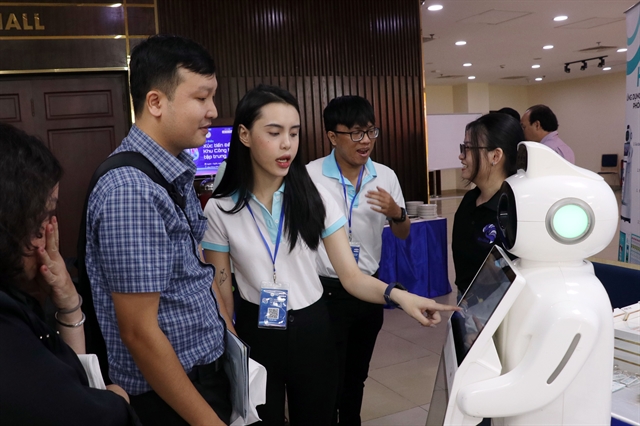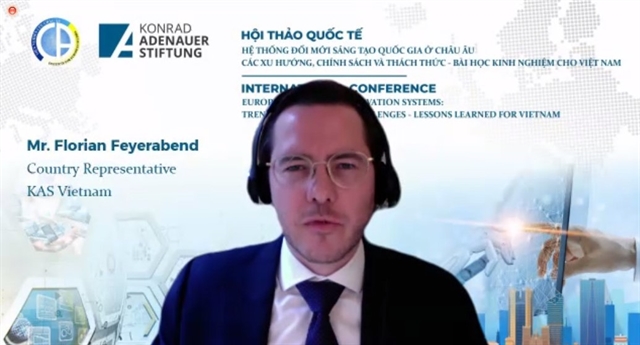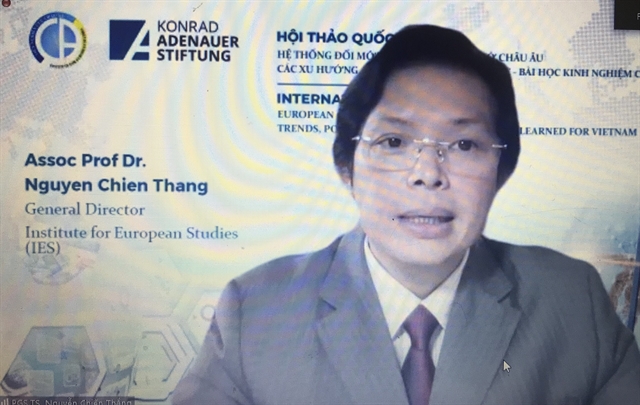 Society
Society


|
| Mr. Florian Feyerabend, KAS Vietnam Resident Representative opens the webinar. — Photos courtesy of the Vietnam Institute for European Studies |
HÀ NỘI — Experts from Việt Nam and Europe have gathered at an online seminar to discuss the application of the National Innovation Systems (NIS) in Việt Nam, a new concept that could bring profound effects.
The Vietnam Institute for European Studies and its parent organisation, the Vietnam Academy of Social Studies, collaborated with the Konrad Adenauer Foundation (KAS) in Việt Nam to organise the webinar “National Innovation Systems in Europe: Trends, Policies, Challenges – Lessons for Việt Nam” on Thursday.
Coined by the late economist Christopher Freeman in the 1980s, the National Innovation System is the network between institutions of both the public and private sectors, where “activities and interactions initiate, import, modify and diffuse new technologies.”
These institutions are the governments who create and enact policies to encourage research and development (R&D), as well as provide funding; the private companies who both invest in and commercialise R&D projects; the R&D organisations and universities who provide innovations; and the intermediaries who connect investors and ideas.
European experience
Germany has invested heavily in innovation, ranked third in the Union for R&D expenses. The European powerhouse spent 3.18 per cent of its GDP in 2019 to invest in new products, services and processes, according to Dr. Pencho Kucev of KAS. Out of this investment, the private sector accounted for almost 70 per cent, educational institutions 18 per cent and the state 12 per cent.
In the case of Finland, Dr. Tomi Särkioja, senior advisor of the Ministry for Foreign Affairs and former co-chairman of the Finland - Vietnam Innovation Partnership Program also commented that, the production value experience a boom in the early 1990s, rose 800 per cent from 1990 to 1996, due to the emergence of firms such as Nokia and products like mobile phones.
These success stories were attributed by both Dr. Kucev and Dr. Särkioja to government incentives that promoted entrepreneurship and fostered innovation.
Vietnamese struggle
Việt Nam has heavily interested in building and promoting its own NIS. Since the announcement of the “Entrepreneurial Year” in 2016, the Government has created organisations such as the National Technology Innovation Fund, the National Foundation for Science and Technology Development and the National Innovation Center.
Initial successes have been recognised. According to the Global Innovation Index, from 71st place of 2014, Việt Nam rose to 42nd in 2020, and is ranked third in ASEAN.
According to Dr. Nguyễn Chiến Thắng, director of the Institute of European Studies, total national expenditure on R&D has increased significantly due to the participation of corporations such as Vingroup and Viettel.

|
| Dr. Nguyễn Chiến Thắng, director of the Institute of European Studies. |
He also noted however, that these results were not enough. Other components of the indexes, such as institutions, human resources and infrastructure have Việt Nam ranked very low, and in need of major improvement – a sentiment shared by academic delegates from Việt Nam. The development in science and technology companies are also not distributed evenly, most notably in central Thừa Thiên-Huế Province.
In identifying the challenges to Vietnamese Innovation, Dr. Võ Xuân Hoài of the National Innovation Center narrowed them down to five hurdles: finance, weak quality of human resources, segmentation of the ecosystem, intellectual property policy and regulation policy. The doctor stressed that barriers in policy should be changed to “compete with countries such as Singapore and Thailand.”

|
| Prof. Đặng Nguyên Anh, Vice President of the VASS, opens the webinar in his keynote address. |
Nurture the future
Despite the challenges, Hoài believes that the potential for Việt Nam to become an innovative country are evident: “a young population with a preference for digital economy, with talented individuals in multiple aspects and great attraction of foreign investment, as well as a proactive government participating and enabling the Fourth Industrial Revolution.”
Việt Nam has a chance to learn from other countries and their models, such as European ones. But applying the ways of others cannot be in a matter-of-fact way, as “every model, even the European NIS has its own pros and cons,” said Dr. Christian Lawrence of the Critical Issues firm Brunswick. Việt Nam must develop and grow the NIS in its own way.
Participants also agreed that the private sector is the cornerstone of the NIS, and state policies should enable and empower them more in innovation.
Both corporations and the government must work together to streamline innovation and socioeconomic development plans, so that the NIS is unified and not fragmented. — VNS




